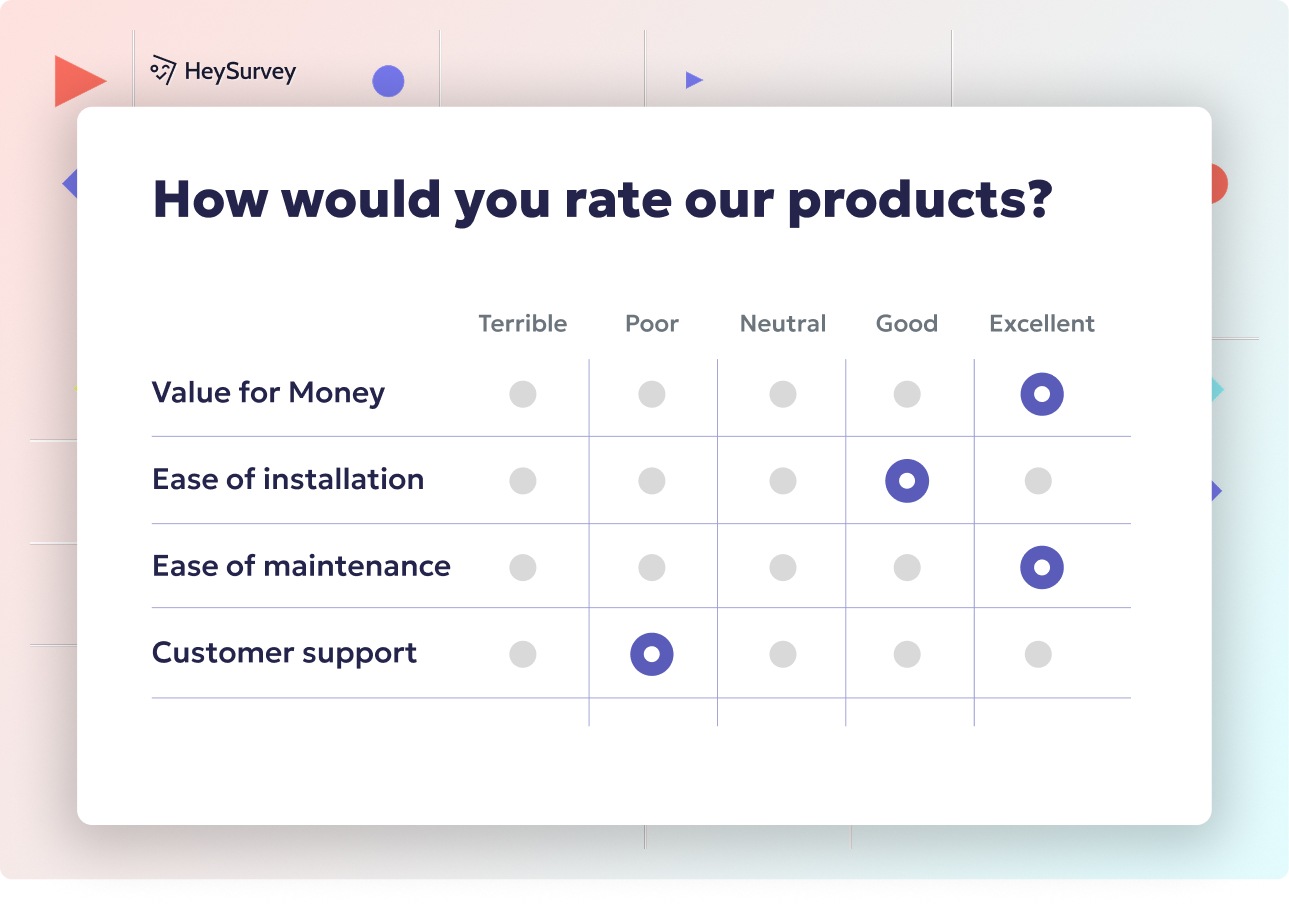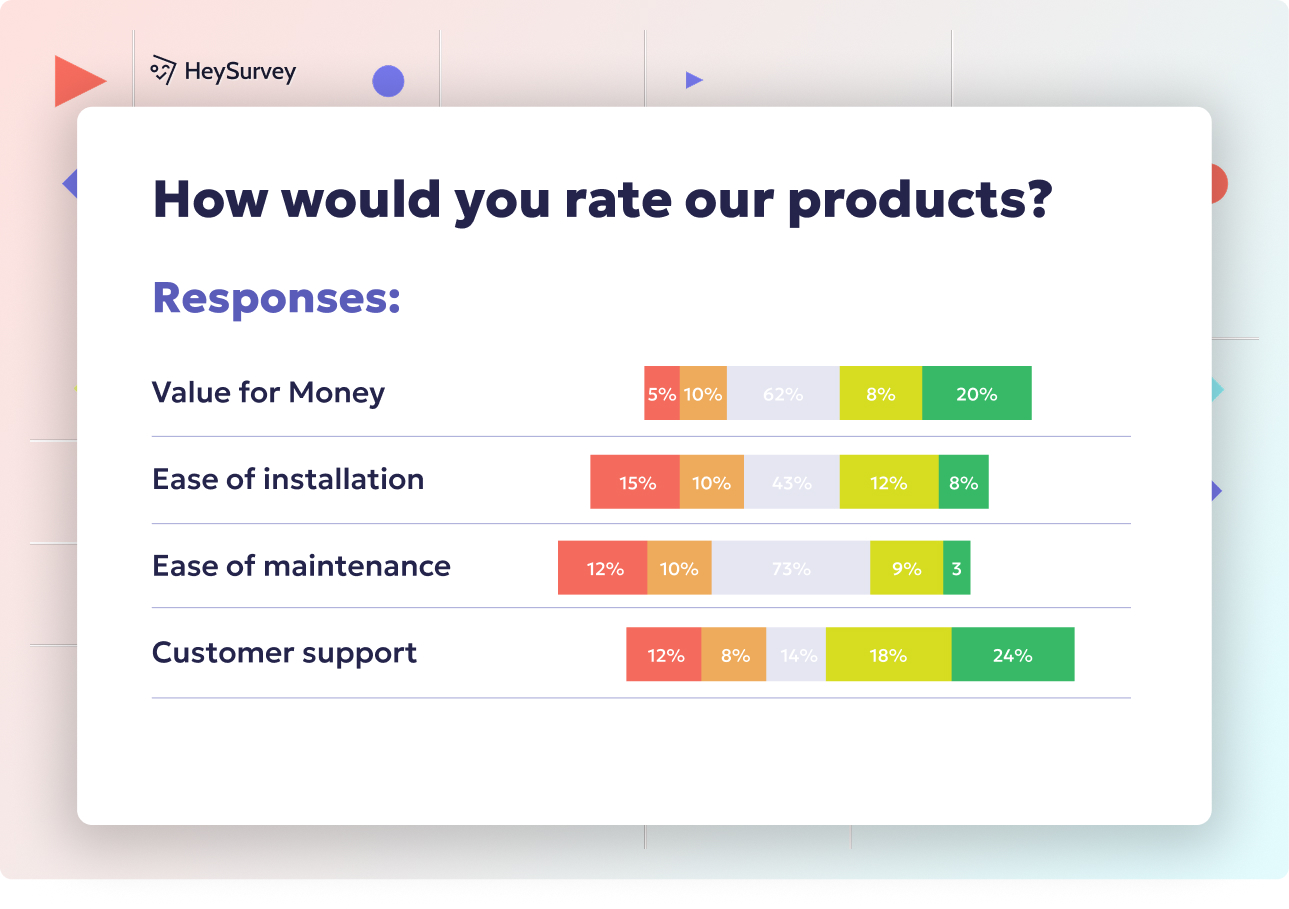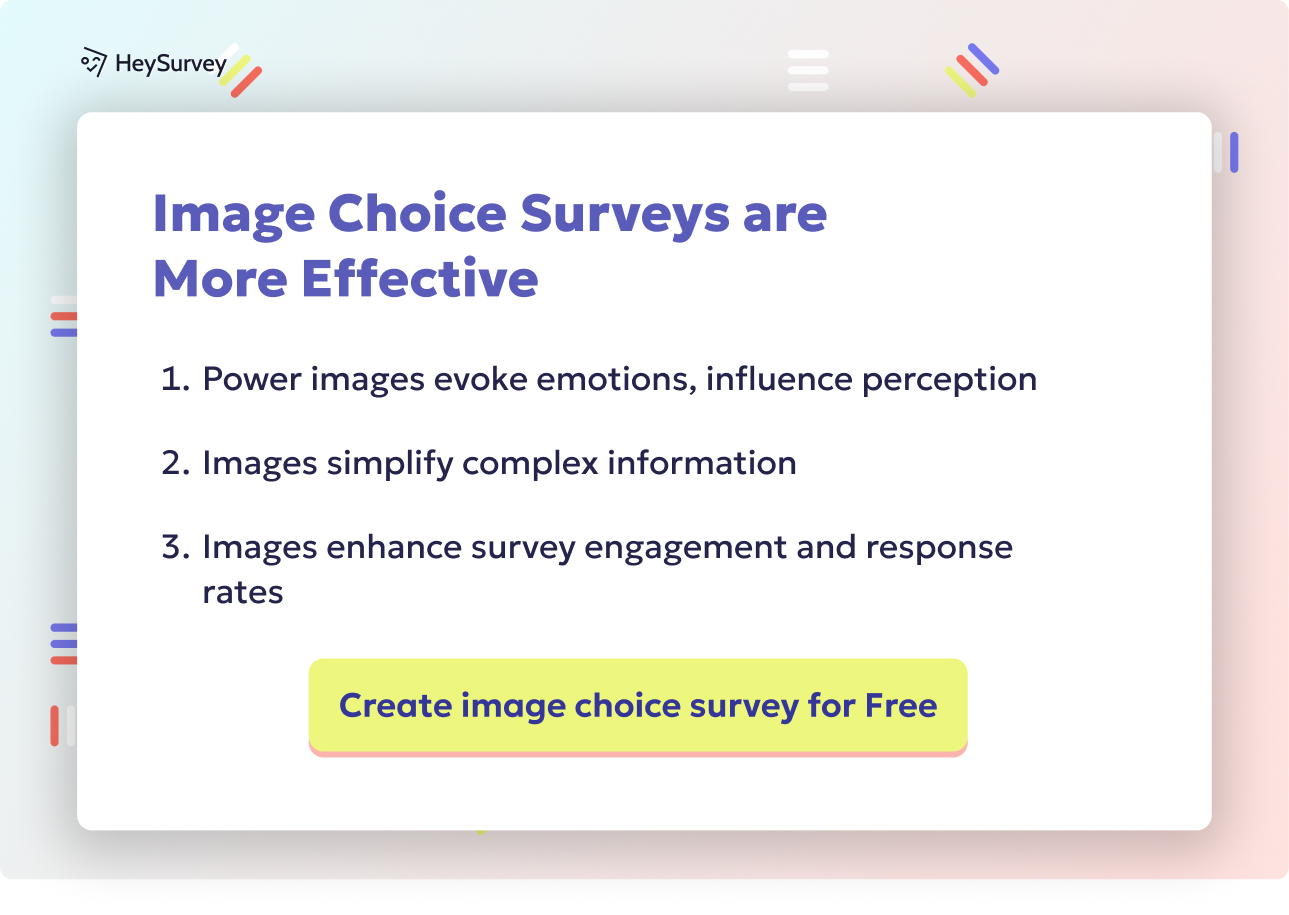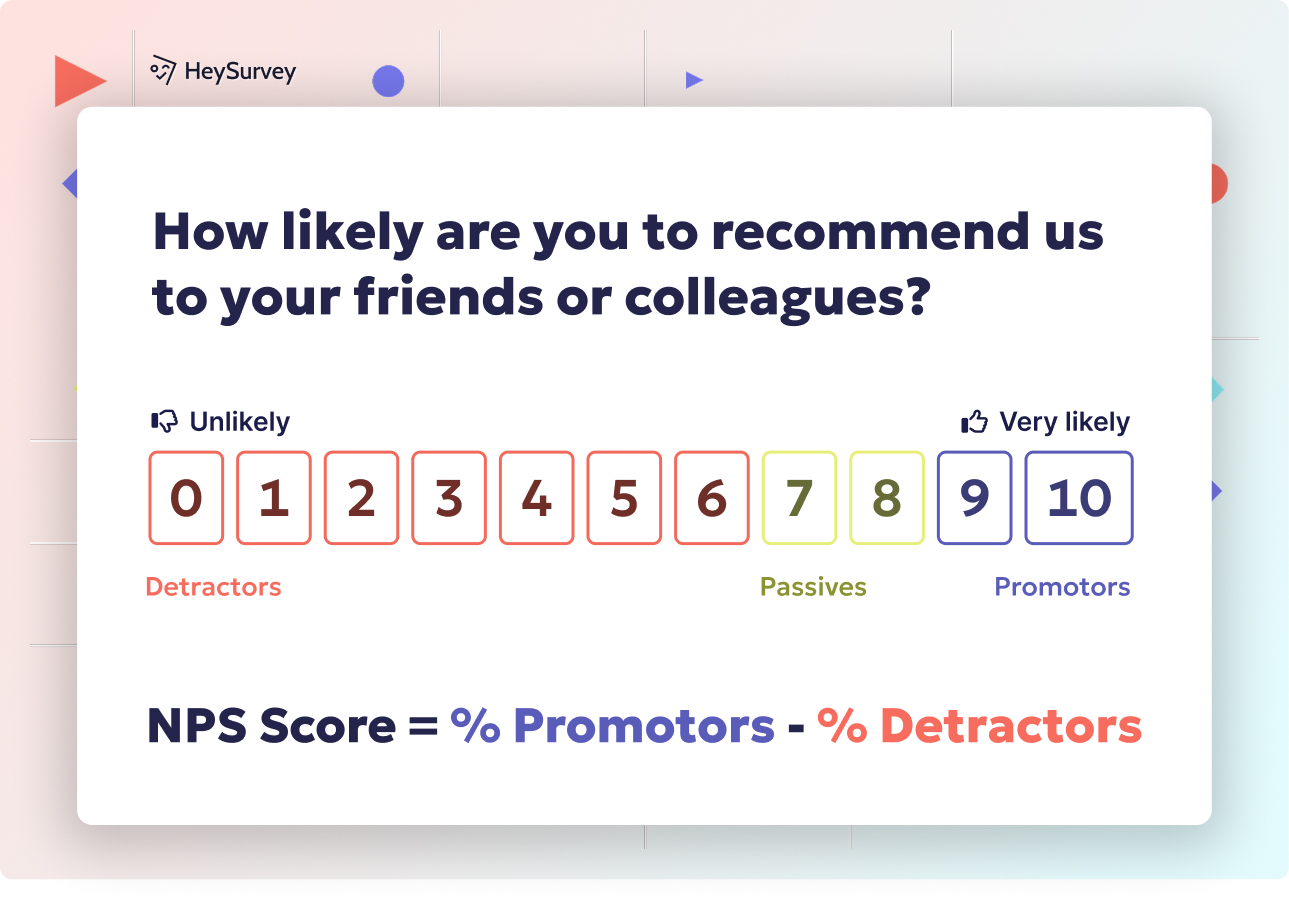25 Principal Survey Questions for Teachers to Improve Leadership
Discover 30 principal survey questions for teachers, including Likert-scale, open-ended, and NPS types to enhance school leadership insight.
Gathering teacher feedback on principals is essential for fostering a thriving educational environment. Structured surveys provide valuable insights into principal performance, guiding professional growth, enhancing teacher morale, and improving school culture. Regular feedback helps identify strengths and areas for improvement, ensuring that leadership aligns with the needs of the teaching staff.
When to Deploy Teacher Surveys
Annual Evaluations: Conducting surveys at the end of each school year offers a comprehensive overview of the principal's performance.
Mid-Year Check-Ins: Implementing surveys halfway through the year allows for timely adjustments and interventions.
After Major Initiatives: Following significant policy changes or new programs, surveys can assess their impact and effectiveness.
When Climate Data Flags Concerns: If there are signs of dissatisfaction or issues within the school environment, surveys can pinpoint specific areas needing attention.
Overview of Survey Question Types
This article explores seven distinct survey question types, each serving a unique purpose:
Likert-Scale Leadership Effectiveness Survey: Measures perceptions of leadership consistency and effectiveness.
Open-Ended Qualitative Insight Survey: Gathers detailed, narrative feedback for deeper understanding.
Multiple-Choice School Climate Survey: Assesses specific aspects of the school environment.
Frequency-Based Behavior Tracking Survey: Monitors the regularity of certain leadership behaviors.
Net Promoter Score (NPS) for Principal Performance: Evaluates overall satisfaction and likelihood of recommending the school.
Ranking & Comparative Priority Survey: Identifies priorities and preferences among various leadership actions.
Semantic Differential Attitudinal Survey: Captures subtle perceptions along bipolar scales.
Each question type complements the others, providing a holistic view of principal performance and areas for growth.
Likert-Scale Leadership Effectiveness Survey
Why & When to Use
The Likert-Scale Leadership Effectiveness Survey is ideal for quantifying teachers' perceptions of their principal's leadership. Its structured format allows for easy benchmarking over time, making it particularly useful during formal evaluations or after implementing new policies to measure shifts in sentiment.
Sample Questions
"The principal communicates a clear, inspiring vision for our school."
"I receive constructive feedback from the principal that helps improve my teaching."
"The principal applies school policies consistently and fairly."
"Decision-making by the principal reflects input from teachers."
"The principal promotes a positive, inclusive school culture."
Research indicates that principals often rate their leadership effectiveness higher than teachers do, suggesting a need for more aligned evaluations. (rand.org)

Creating your principal survey with HeySurvey is a breeze—even if you’re a newbie! Just follow these simple steps and you’ll have a professional, effective survey ready to go in no time.
Step 1: Create a New Survey
Start by heading to HeySurvey and clicking the “New Survey” button. You can choose to start from scratch or grab a template to save time. For principal surveys, there are handy templates available to jumpstart your setup with questions already tailored for school leadership feedback. No account? No worries—you can begin without one! But remember, you’ll need an account to publish and view results.
Step 2: Add Your Questions
Once in the Survey Editor, it’s time to add your questions. Click “Add Question” to choose from various types like Likert scales, multiple-choice, or open-ended text. HeySurvey lets you easily type your questions, reorder them, and set which ones are required. To spice things up, add images or use markdown to style your questions with bold or bullet points. You can also set up branching if you want certain questions to appear based on previous answers.
Step 3: Publish Your Survey
Happy with your masterpiece? Hit the Publish button to get a shareable link you can send to teachers. If you don’t have an account yet, you will be prompted to create one to unlock publishing. HeySurvey’s responsive design means your survey looks great on phones, tablets, or desktops—perfect for busy educators on the go.
Bonus Step 1: Apply Branding
Want your survey to look unmistakably like it came from your school or district? Upload your logo and customize colors and fonts in the Designer Sidebar. This adds a professional flair and boosts teacher trust.
Bonus Step 2: Define Settings
Set survey start and end dates, limit responses, or add a redirect URL for when teachers complete the survey. You can even let respondents view live results for certain question types to make the process more transparent.
Bonus Step 3: Skip Into Branches
Use advanced branching to tailor question flow based on answers. For example, if a teacher rates communication poorly, the next question can dig deeper there. This smart routing helps you gather the most relevant insights without overwhelming respondents.
Ready to dive in? Open a survey template with the button below and watch your teacher feedback roll in!
Create Your Survey Now
Open-Ended Qualitative Insight Survey
Why & When to Use
Open-Ended Qualitative Insight Surveys capture nuanced feedback, context, and suggestions that closed questions might miss. Deploying these surveys after major initiatives or when numerical scores dip provides actionable details for improvement.
Sample Questions
"Describe one action the principal has taken this year that most supported your professional growth."
"What obstacles, if any, hinder effective communication with the principal?"
"Which leadership behaviors would you like to see the principal model more often?"
"Share an example of how the principal handled a challenging situation well—or poorly."
"List one change that would most improve the principal–teacher relationship."
Open-ended survey questions enable teachers to provide detailed, actionable feedback on evaluation systems, leading to significant improvements when their input is valued and acted upon. (aft.org)
Multiple-Choice School Climate Survey
Why & When to Use
Multiple-Choice School Climate Surveys offer quick pulse checks on specific leadership facets, making them easier for busy teachers to complete. They enable categorical analysis and are useful quarterly or after policy rollouts to gauge immediate reactions.
Sample Questions
"Which communication channel from the principal do you find most effective?
a) Email
b) Staff meetings
c) Classroom drop-ins
d) School app.""How clear are the principal’s academic expectations?
a) Very clear
b) Somewhat clear
c) Unclear
d) Not communicated.""When conflicts arise, the principal’s response is:
a) Proactive
b) Reactive
c) Inconsistent
d) Unsure.""Professional development offered by the principal is:
a) Highly relevant
b) Moderately relevant
c) Slightly relevant
d) Not relevant.""Overall, the principal’s visibility in classrooms is:
a) High
b) Moderate
c) Low
d) Very low."
Frequency-Based Behavior Tracking Survey
Why & When to Use
This survey measures how often specific leadership behaviors occur, which is vital for accountability. It's best used monthly or mid-semester to monitor ongoing initiatives, such as instructional rounds.
Sample Questions
"How often does the principal visit your classroom for non-evaluative walk-throughs?"
"How frequently does the principal provide timely follow-up after observations?"
"How often are staff meetings used to celebrate instructional successes?"
"How regularly does the principal solicit teacher input before making key decisions?"
"How often does the principal recognize student achievements publicly?"
Regular principal classroom visits and timely feedback significantly enhance teacher satisfaction and instructional quality. Source
Net Promoter Score (NPS) for Principal Performance
Why & When to Use
The NPS provides a single metric that captures overall loyalty and advocacy, allowing for benchmarking across schools. It's particularly useful district-wide or during leadership transitions to compare principals objectively.
Sample Questions
"On a scale of 0–10, how likely are you to recommend working at this school to a colleague, based on the principal’s leadership?"
"What is the primary reason for the score you just gave?"
"What one change would most increase your likelihood to recommend?"
"Which aspect of the principal’s leadership most influences your rating?
a) Communication
b) Support
c) Vision
d) Fairness.""Have you encouraged another teacher to apply to this school in the past year?
a) Yes
b) No."
Ranking & Comparative Priority Survey
Why & When to Use
This survey reveals the relative importance of various leadership actions, guiding resource allocation. It's best used during strategic planning or budget cycles.
Sample Questions
"Rank the following leadership areas in order of where you need the most support:
a) Classroom management
b) Curriculum alignment
c) Data analysis
d) Parent communication
e) Technology integration.""Arrange these school-wide initiatives from most to least effective under the principal’s guidance:
a) PBIS
b) PLCs
c) SEL programs
d) STEM coaching.""Rank the principal’s strengths:
a) Vision
b) Feedback
c) Empathy
d) Organization.""Prioritize which professional-development formats the principal should offer next year:
a) Workshops
b) Coaching
c) Peer observations
d) Online modules.""Order the factors that influence your job satisfaction:
a) Leadership support
b) Student behavior
c) Resources
d) Colleague collaboration."
Semantic Differential Attitudinal Survey
Why & When to Use
This survey captures subtle perceptions along bipolar scales, highlighting the tone and style of leadership. It's useful at the start and end of the school year to measure attitudinal shifts.
Sample Scales
"Decision-making:
Impulsive 1–2–3–4–5 Deliberate.""Vision clarity:
Vague 1–2–3–4–5 Crystal clear.""Communication style:
One-way 1–2–3–4–5 Collaborative.""Support level:
Minimal 1–2–3–4–5 Extensive.""Conflict resolution:
Avoidant 1–2–3–4–5 Proactive."
Best Practices: Dos & Don’ts for Crafting Principal Survey Questions
Dos
Align Questions with District Leadership Standards and Teacher Priorities: Ensure that survey questions reflect the values and goals of both the district and the teaching staff.
**Ensure Anonymity to Encourage Honest
Related Leadership Survey Surveys

31 Board Survey Questions: Guide to Evaluating Board Performance
Discover 28 essential board survey questions across seven types to enhance board evaluation, effe...

30 Leadership Survey Questions to Assess and Improve Effectiveness
Explore 30 detailed leadership survey questions with insights on assessing leadership effectivene...
